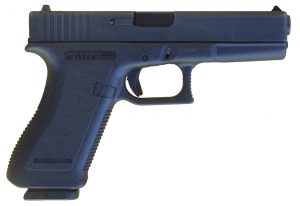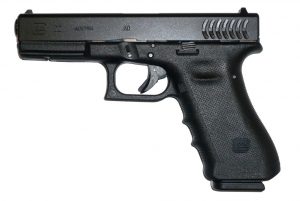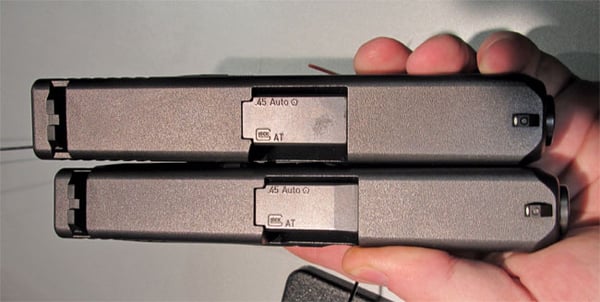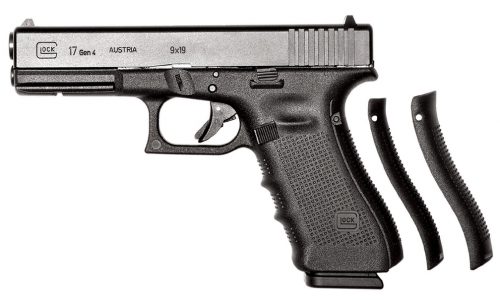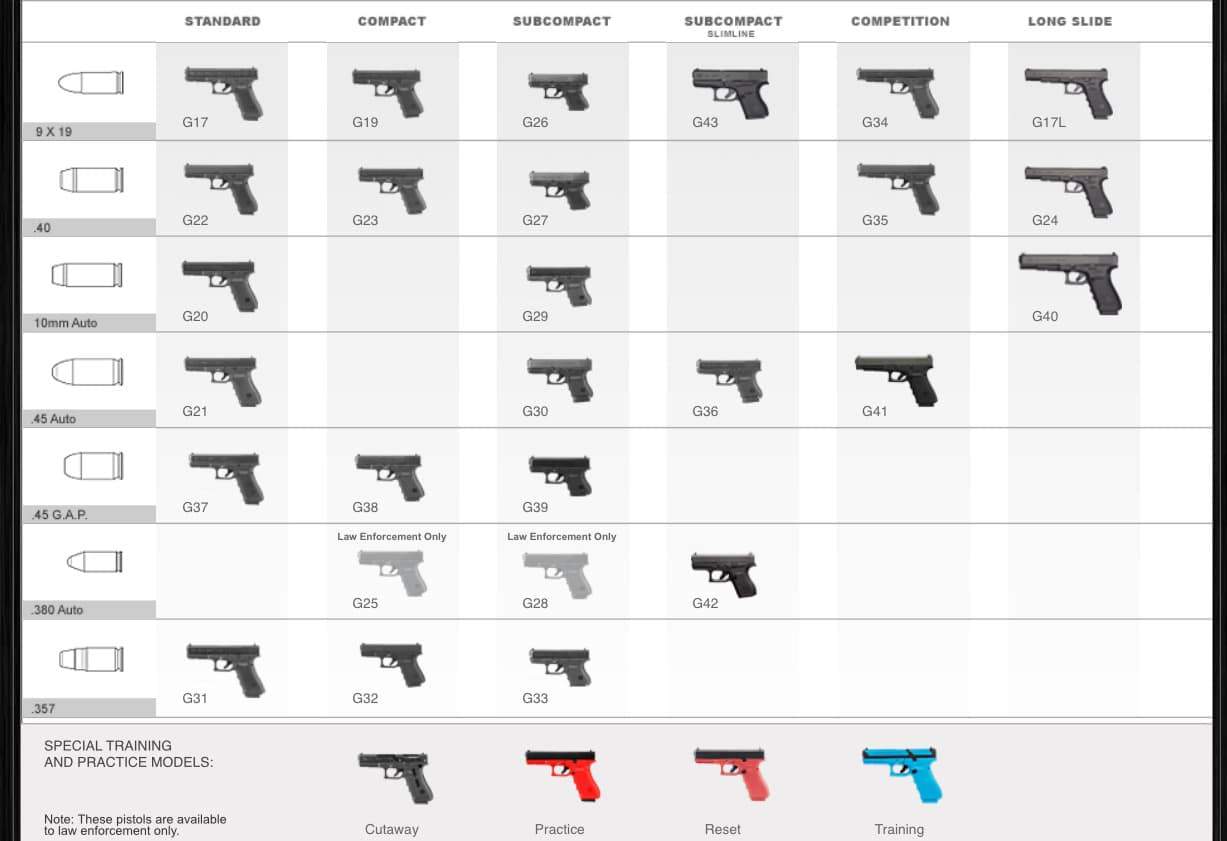Gaston Glock and Firearms Innovation
Glock.
Without question, among the most recognizable brands within the firearms industry; certainly among novice shooters and first-time gun owners. The reason for this? Glock has built a reputation second to none on the pillars of dependability, durability, resilience, and quality. It is widely claimed that you can throw a Glock in the dirt, and even leave it in salt water for a month – and it will function. Of course, this kind of abuse is not recommended, but passing such torture tests with ease is comforting when purchasing a life-saving tool. Short of being blown up, Glocks are essentially indestructible.
Gaston Glock is definitely an innovator like few others.
What Steve Jobs was to Apple, Gaston Glock is to Glock, Inc. and firearms as a whole. He didn’t start with such a benefit of the doubt though. In 1963, Mr. Glock had a plastics company in Vienna, producing components for the Austrian military. Soon, realizing the advantage of combining plastic and steel insofar as durability, Glock began building certain parts in this fashion and supplying the military.
In 1981, Glock overheard two military officials lamenting about how no one could build military sidearms to meet their specifications. Glock proceeded to interject in the conversation and offered to build such a sidearm; promising to not only meet the specifications but exceed them. He was initially laughed at, and being much like Steve Jobs, Gaston Glock is not someone to be ridiculed and/or second-guessed. He immediately began working on designing the new pistol after being invited to the bidding process, in spite of having no experience in arms manufacturing. The result? In 1983, he so impressed the Austrian military with his revolutionary design that they ordered 25,000 Glock pistols.
Generation 1 Glocks consisted of a full-size Glock 17, released in 1985, chambered in 9mm, boasting a capacity 17+1 [in the chamber], and a compact Glock 19, with 15+1 capacity released in 1988, likewise chambered in 9mm. The Glock 17 became enormously popular amongst law enforcement agencies, and the Glock 19 was popularized by civilian consumers in the United States due to its smaller form-factor and thus ease of concealment.
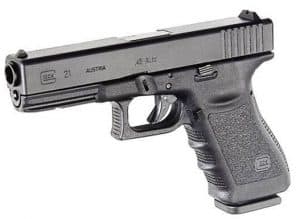 Initially, just like the military, civilian consumers laughed at the idea of polymer guns.
Initially, just like the military, civilian consumers laughed at the idea of polymer guns.
If only because to that date, in an era dominated by steel firearms, no one could imagine that a plastic gun could survive even one gunshot. What people failed to recognize is that a plastic [frame] exterior combined with reinforced metal internal parts is nothing short of genius! It provides a lightweight pistol that is just as capable as its predecessors. Furthermore, polymer is a shock absorber and thus considerably reduces recoil. And, even though polymer is lighter in weight – if a pistol is balanced correctly recoil is not a problem. Now, this fact of plastic guns once not being accepted is funny to think about because the market is dominated with polymer handguns. Even rifles such as the AR-15 from every manufacturer are by and large made from polymer – because of Glock.
Glock then went on to produce big-bore models: the G20 and G21; chambered in 10mm and .45ACP, respectively. When the FBI, in collaboration with Smith & Wesson created the .40S&W cartridge in 1990, Glock answered the call with the G22, a full-size model, and G23, a compact pistol. Following suite because of increased demand from the growing concealed carry market, Glock also released the G25, chambered in .380, and then later the G26 (9mm) and G27 in (.40S&W).
Modular Glock: Serrated Triggers & More Powerful Cartridges
As noted earlier, Gen 1 Glocks comprised the G17 and very early G19s. Currently, Glocks are in their 4th generation, and all throughout, there are few, and yet significant changes to the overall design. For example, the gen 1 G17 had a smooth trigger, whereas the G19 has a serrated trigger. For those that prefer the smooth trigger, the G19 can be retrofit because like-generation parts are interchangeable.
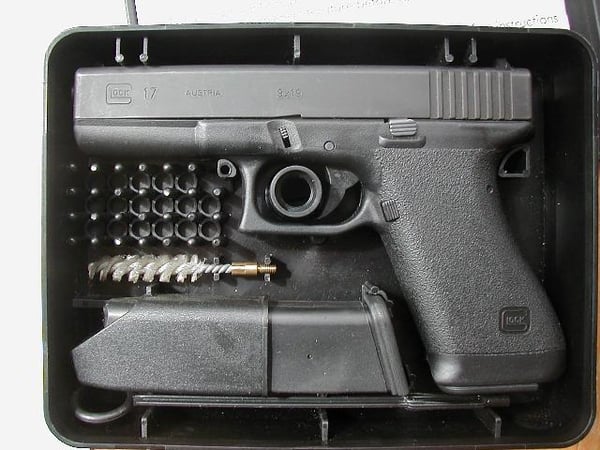
Generation 2 retextured the grip surface.
The rectangular checkering on the front and back of the grip is referred to as “grenade” checkering. Around 1990, Glock began importing the G20 (10mm), G21 (.45ACP) and the G22 and G23 (.40S&W). The G22 and 23 are essentially .40S&W versions of the G17 and 19, respectively. Albeit, the more powerful cartridge necessitated a design change; an additional locking pin to retain the locking piece to the frame. Gen 2 Glocks can be distinguished from Gen 1 by a circular cartouche on the left front corner of the trigger guard, as pictured. The latter half of Gen 2 Glocks also changed the coloring of internal parts from black to silver.
It is important to note though that this is not always a reliable indicator because older guns being serviced likewise received these upgrades.
“Shortly after the change from two-letter to three-letter serial numbers, a second line was added to the lower cartouche on the grip with two additional patent numbers. The next internal upgrade in this approximate chronology was angled cuts made to the interior of the frame to relieve the back two corners where the locking piece sits. Without this modification, those two corners were prone to the initiation of vertical cracks in the polymer due to the repeated impact of the corners of the metal locking piece to the frame. The relief cuts seemed to prevent the occurrence and could also be added to older models after the cracks had begun (essentially removing the cracks in the process of making the cuts at their location)” (Brudennell, 2014)
Gen 3 Glocks incorporated all of the aforementioned upgrades.
With some models, in particular, those chambered in .357 SIG having finger grooves and no accessory rail, but these are rare. Additional changes in Gen 3 included the model 29 (10mm), G30 (.45ACP), 31-33 (.357 SIG), 34 (9mm), 35 (.40S&W), and the slime-frame G36, which was unique because it is a .45ACP pistol, with the slide dimensions of the 9mm, and even thinner single stack frame. At SHOT Show, 2013, Glock introduced the 30s, combining the traditional wide frame of the G30 (.45 ACP), with a slim slide similar to the 36.
In January 2010, Glock introduced the Gen 4.
Notable changes include a smaller grip circumference, add-on backstraps, a captive dual spring recoil assembly, a truncated pyramid grip texture and a larger, reversible magazine release.
There are also smaller changes in the barrel, slide, trigger bar, trigger housing, the deletion of a cutout on the front of the grip for magazine removal, and the additional notch on the magazines for left-handed magazine release (CTD Blogger, 2011).
Glocks at a Glance:
Here is a look at Glocks' current production line:
Source: Glock U.S.A.
| Model number | Cartridge | Total length | Barrel length | Magazine capacity | Weight (unloaded) |
Style | ||||
|---|---|---|---|---|---|---|---|---|---|---|
| (mm) | (in) | (mm) | (in) | Standard | Optional | (g) | (oz) | |||
| 17*^, 17C | 9×19mm | 186 | 7.32 | 114 | 4.49 | 17 | 10, 33 | 625 | 22 | Standard |
| 17L | 225 | 8.69 | 153 | 6.02 | 670 | 23.6 | Long slide | |||
| 18, 18C | 185 | 7.28 | 114 | 4.49 | 33 | 10, 17 | 620 | 21.9 | Standard | |
| 19*^, 19C | 174 | 6.85 | 102 | 4.01 | 15 | 10, 17, 33 | 595 | 21 | Compact | |
| 20*, 20C, 20SF | 10 mm Auto | 193 | 7.60 | 117 | 4.61 | 10 | 785 | 27.7 | Standard | |
| 21*, 21C, 21SF | .45 ACP | 13 | 10 | 835 | 29.84 | |||||
| 22*, 22C | .40 S&W | 202* 204 | 7.95* 8.03 | 114 | 4.49 | 15 | 10, 22 | 725 | 25.59 | |
| 23*, 23C | 185* 187 | 7.28* 7.36 | 102 | 4.01 | 13 | 10, 15, 22 | 670 | 23.65 | Compact | |
| 24, 24C |
225 | 8.86 | 153 | 6.02 | 15 | 10, 17, 22, 24 | 757 | 26.7 | Long slide | |
| 25 | .380 ACP | 174 | 6.85 | 102 | 4.01 | 17 | 570 | 20.1 | Compact | |
| 26* | 9×19mm | 160 | 6.30 | 88 | 3.46 | 10 | 15, 17, 33 | 560 | 19.8 | Subcompact |
| 27* | .40 S&W | 9 | 11, 13, 15, 17, 22, 24 | 560 | 19.8 | |||||
| 28 | .380 ACP | 10 | 12, 15, 17 | 529 | 18.7 | |||||
| 29*, 29SF | 10 mm Auto | 172 | 6.77 | 96 | 3.78 | 15 | 700 | 24.7 | ||
| 30*, 30S, 30SF | .45 ACP | 9, 13 | 680 | 24 | ||||||
| 31*, 31C | .357 SIG | 186 | 7.32 | 114 | 4.49 | 15 | 10, 17 | 660 | 23.3 | Standard |
| 32*, 32C | 174 | 6.85 | 102 | 4.01 | 13 | 10, 15, 17 | 610 | 21.5 | Compact | |
| 33* | 160 | 6.30 | 88 | 3.46 | 9 | 10, 11, 13, 15, 17 | 560 | 19.8 | Subcompact | |
| 34*^ | 9×19mm | 207 | 8.15 | 135 | 5.31 | 17 | 10, 33 | 650 | 22.9 | Competition |
| 35*^ | .40 S&W | 15 | 10, 17, 22, 24 | 695 | 24.5 | |||||
| 36 | .45 ACP | 172 | 6.77 | 96 | 3.78 | 6 | — | 570 | 20.1 | Slimline |
| 37* | .45 GAP | 186 | 7.32 | 116 | 4.56 | 10 | 11 | 735 | 25.9 | Standard |
| 38 | 174 | 6.85 | 102 | 4.01 | 8 | 9, 10, 11 | 685 | 24.2 | Compact | |
| 39 | 160 | 6.30 | 88 | 3.46 | 6 | 7, 8, 9, 10, 11 | 548 | 19.3 | Subcompact | |
| 40*^ | 10 mm Auto | 241 | 9.49 | 153 | 6.02 | 15 | 10 | 798 | 28.15 | Long slide |
| 41*^ | .45 ACP | 222 | 8.74 | 135 | 5.3 | 13 | 775 | 27 | Competition | |
| 42 | .380 ACP | 151 | 5.94 | 83 | 3.27 | 6 | — | 380 | 13.4 | Slimline |
| 43 | 9×19mm | 159 | 6.26 | 86 | 3.39 | 509 | 17.95 | |||
Source: Wikipedia
Glock Holsters and accessories: Interchangeability and variety of choice
Lastly, it is important to note that, although you will need individual holsters for some Glocks, there is a level interchangeability. For example, one holster will fit the G19, 23, 32 and 36. Size of the slide is important, but when it comes to gun/holster fit, what's most important is the size and shape of the trigger guard.
Additionally, there is no shortage of neither holsters or accessories (e.g. light/laser mounts, guide rod lasers, [extended] magazines, sights and anything else). Holsters span inexpensive (but not cheap) price points to being considerably priced. In short, what Apple is to computers Glock is to firearms; there is no shortage of any type of parts and/or accessories. Dare I say, Glocks [to an extent] are kind of like 1911s, in that you could customize any part of the gun any way you want.
Here is a great guide to holsters
In this way, Glock continues to innovate, pushing the entire industry. Their presence is unlike any other, and they are here to stay.
Sources:
Glock Generations: Detail and Feature Evolution
AAron Brudenell
http://www.sadefensejournal.com/wp/?p=2730
The Shooter’s Log: Glock History
CTD Blogger
http://blog.cheaperthandirt.com/glock-history/
By Rafal Rybak
Rafal is a 34-year-old first-generation Polish-American immigrant and living with Cerebral Palsy. He is a long-time Maxon customer, firearms enthusiast, and an accomplished technical writer. He has a Master's Degree in Communication, Media & Theatre from Northeastern Illinois University, and is most passionate about areas of identity & difference, and strives to empower people.



